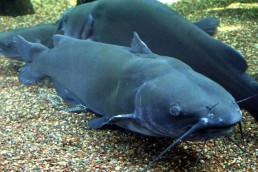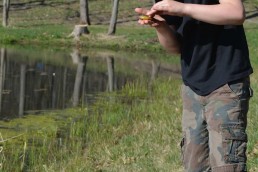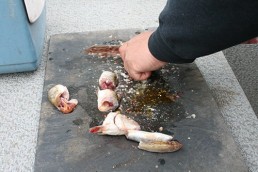The Midwest: Catfish Paradise
SHARE THIS POST
Catfish as a sport fish may not have the cachet of bass or trout, but as table fare, they’re unrivaled. It doesn’t matter whether you go after blues, channel cats, flatheads or bullheads, the Midwest has whiskerfish aplenty.
Despite an ability to grow immensely and a willingness to clamp down on many different kinds of bait, catfish are accorded respect by too few anglers. Sure, catching a 2-pound bass is fun, but catching a 20-pound catfish is even more fun according to some anglers, including myself. And in all regions, catching a 20-pounder isn’t all that difficult. Furthermore, a tasty bonus comes with this action: For every monster catfish that swims in a state’s waters, many smaller cats—each just the right size as the main ingredient for a fish fry—are waiting to take your bait. No matter how you cut it, big fish or small, river or lake or pond, the regional catfish angler can’t go wrong.
What’s in a name?
Catfish are a diverse group. Named for their prominently displayed “barbels,” which are slender, whisker-like sensory organs located on the head, these creatures swim in environments of many kinds with species found on every continent except Antarctica. Catfish have no scales, but do possess a strong, hollow ray in their dorsal and pectoral fins, through which a stinging substance can be delivered when the fish is irritated.
The channel cat (Ictalurus punctatus) is among one of the most sought-after sport fish. The diet of catfish is markedly varied, consisting of insects, small fish, frogs and freshwater mollusks, as well as seeds carried in water. Although trolling minnow-imitation lures do occasionally result in a catfish being caught, most are taken on dead or live bait. Chicken livers, shrimp, large worms, fish belly strips and stink baits all attract catfish.
If you are boat fishing, try and anchor above a known catfish hot spot. The creatures tend to congregate around underwater mounds, so cast and retrieve slowly. Your rod tip will bend as you drag a sinker up the side of a mound. When the tip straightens, you are more than likely on the ridge of a mound. Prepare for a strike as you slowly work your bait down the side. Remember, catfish are slow eaters, so be patient before setting the hook.
Catching catfish from shore
One doesn’t need a boat to enjoy great catfishing. In many parts of the U.S., including the Midwest, lots of whiskerfish fans pursue their quarry from shore. The following tips may help increase your catch:
Select bank-fishing sites near prime catfish-holding areas—perhaps a shore clearing near a river’s outside bend, a spot beside a pond levee or a gravel bar adjacent to a deep hole in a stream. Ideal fishing sites have brush-free banks that facilitate easy casting.
When bank fishing on a river, you can fish different locations simply by letting your bait drift in the current beneath a bobber. This activity allows bait to move naturally downstream, flowing through rapids and settling enticingly in catfish holes.
No matter where you bank-fish, don’t drop your guard when landing a big cat. And a long-handled net is best for catching large fish. Still, there are times when beaching a fish may be necessary. If you anticipate this possibility, keep your drag set and pull the catfish up on land before attempting to remove the hook.
Additional catfishing tips
Remember: Flathead cats prefer live bait, whether it’s small bream, shiners or shad. Blue catfish favor live and cut shad. Channel cats will often bite on most anything, live or dead, organic or not. The best time to fish for catfish is from sunset to midnight.
Caring for your catch
Now that you’ve gone catfishing and had a profitable time, here are some suggestions on what to do with your treasure: To store in the freezer, follow these guidelines: 1). Remove skin from the catfish fillet with a super-sharp knife. 2). Always cut out the bones before packing away. 3). Vacuum-seal and freeze your catches. If you can’t afford vacuum bags or lack the time, cut the fillet into meal-sized portions. Wipe away any excess water or blood with a paper towel, then individually wrap fillets in plastic, squeezing the air out before sealing completely. 4). After freezing, allow a day to thaw in the refrigerator.
Recipes
Catching this species is definitely fun, but it can’t compare with afterward, when sinking your teeth into a golden fillet that has been cooked to perfection. You can never go wrong with this old favorite:
Platte River Pan-fried Catfish
2 pounds catfish fillets
1/3 cup flour
1 1/2 teaspoons salt
1 teaspoon freshly ground pepper
2 eggs (slightly beaten)
1 cup cornmeal
Vegetable oil (for frying)
Lemon wedges
Rinse fish under cold water and pat dry with paper towels. Mix the flour with salt and pepper. Spread mixture on wax paper. Put eggs in a shallow bowl and cornmeal on another piece of wax paper. Dust each fillet in the seasoned flour and shake off excess. Dip a fillet into the egg and let excess run off. Then dip fillet in cornmeal. Warm a good-sized platter, pan or skillet on the oven. In the large skillet, heat 1/4-inch of vegetable oil. When you feel heat rising from the oil, place the fish in the pan. Brown the fish on each side. Don’t crowd the skillet; do only a few fillets at a time. Place on a paper towel to drain. Transfer to the platter and continue frying fillets. Serve with lemon wedges.
Are you enjoying this post?
You can be among the first to get the latest info on where to go, what to use and how to use it!
Blackened Catfish with Lemon Butter (recipe best prepared outdoors)
4 catfish fillets
1/3 pound of bacon
2 teaspoons each of garlic powder, thyme, white pepper,
black pepper, cayenne pepper, lemon pepper, chili powder,
crushed rosemary and crushed fennel seed.
1 teaspoon allspice
1 teaspoon oregano
1/2 teaspoon salt
Olive oil
Fry the bacon and retain the grease. Combine all dry ingredients. Rub the fillets with olive oil, then coat with spices. Drop in the hot bacon grease and cook until you can easily flake fillets with a fork. Serve with lemon butter, consisting of 1/4 cup of melted butter, 1 teaspoon lemon juice, 1/2 teaspoon of Tabasco sauce and sliced green onions.
Catfish Salad
1 pound of cooked fillets, cut into bite-sized portions.
2 medium-sized tomatoes, coarsely chopped
1 avocado, cubed
1/3 cup chopped green onions
1/4 cup sliced green olives
1/2 cup classic white wine vinaigrette with Chardonnay
7 cups torn lettuce
In a bowl, combine fish, tomatoes, onions and olives. Add vinaigrette with Chardonnay and toss. Chill for one hour. Remove from refrigerator and mix well with the lettuce. Serve.
The Midwest has enough fast-action angling for whiskerfish to suit the sporting demands of many fishermen. As table fare, catfish are unrivaled, and the bodies of water all around this state are filled with good-sized fish. These creatures may not be all that appetizing to look at, but try telling your full stomach that after eating a mess of what many people consider the best- tasting fish around.
Joe Zentner has caught and released fish from the Midwest to the Atlantic Coast. His articles have appeared in a variety of publications.
MWO
SHARE THIS POST
Did you enjoy this post?
You can be among the first to get the latest info on where to go, what to use and how to use it!
Joe Zentner
Joe Zentner has caught and released fish from the Midwest to the Atlantic Coast. His articles have appeared in a variety of publications.



